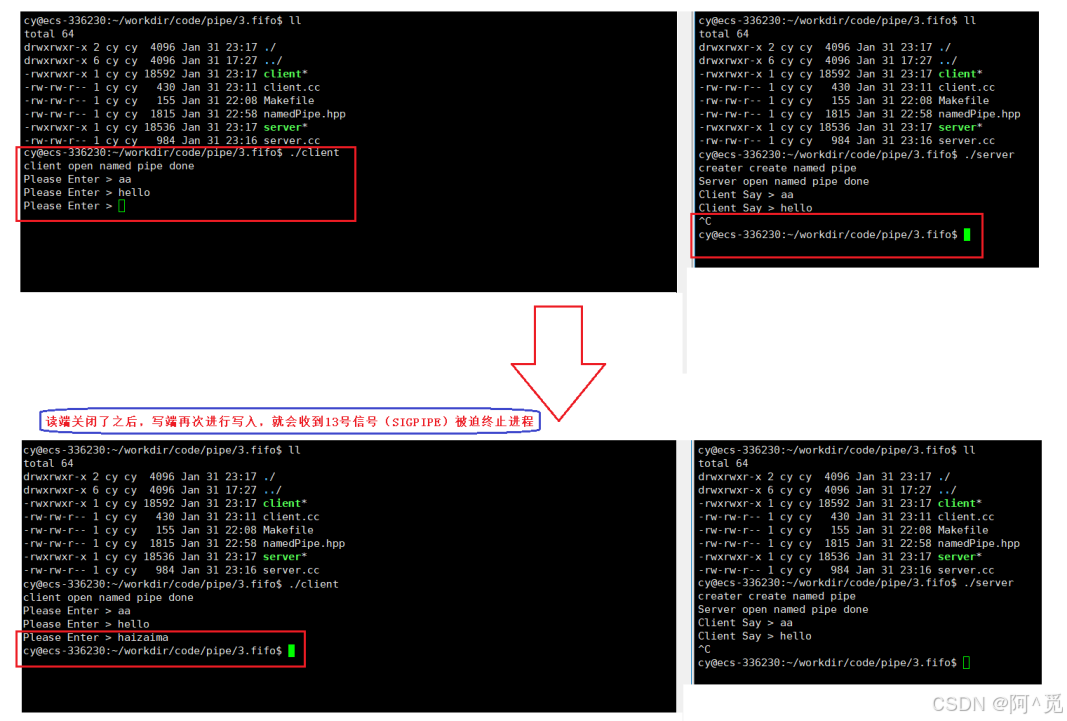Linux - 进程间通信(3)
目录
3、解决遗留BUG -- 边关闭信道边回收进程
1)解决方案
2)两种方法相比较
4、命名管道
1)理解命名管道
2)创建命名管道
a. 命令行指令
b. 系统调用方法
3)代码实现命名管道
构建类进行封装命名管道:
构造和析构:
读取管道、写入管道:
server.cc (读端):
client.cc(写端):
效果:
4)疑点解决
写端未来,读端open调用阻塞
读端关闭,写端继续写入
5)完整代码
namedPipe.hpp:
server.cc:
client.cc:
3、解决遗留BUG -- 边关闭信道边回收进程
1)解决方案

我们仍然想用上述方法进行管道和子进程的回收
-- 则需要解决子进程所继承的父进程遗留的多余wfd,我们在每次创建子进程时,遍历所有之前的信道,关闭掉wfd即可,就不会出现,多个wfd指向一个管道

2)两种方法相比较
退一个回收一个:

先全部退出,再进行等待回收:

4、命名管道
1)理解命名管道

命名:该管道有名字,因为该文件有路径,有路径必有文件名
管道:依旧是一个内存级的基于文件进行通信的通信方案
属性、操作、文件内核缓冲区同一个文件的都是差不多的,因此不用再创建一份,操作系统不做浪费时间和空间的事情
我们怎么保证两个毫不相关的进程打开了同一个文件呢??
每一个文件,都有文件路径(唯一性)
2)创建命名管道
a. 命令行指令



一个进程(echo)向命名管道里面输入数据
一个进程(cat)向命名管道里面读取数据
这样就实现了两个毫不相关的进行之间的通信


创建了三个窗口,一个一直向管道输入,一个一直读取,一个手动检测管道大小
但是我们可以看到管道文件(myfifo)的大小一直显示0
因为 FIFO0 文件虽存在于文件系统中,但其内容都存放在内存里,不会将通信数据刷新到磁盘中,所以在磁盘上显示的文件大小始终为0
b. 系统调用方法
使用mkfifo即可创建管道文件
使用unlink即可删除一个管道文件(当然,rm也可以删除)
3)代码实现命名管道
创建两个.cc文件分别模拟两个进程,一个进行发送,一个进行读取
通过一个CreateNamedPipe和一个RemoveNamedPipe就可以实现对管道生命周期的管理
当然,我们管理管道的声明周期时,肯定是将创建和删除交给同一个文件去做比较好,因为它清楚什么时候去删除合适
这里我们让发送的那方去管理管道的生命周期
构建类进行封装命名管道:
我们需要创建管道的路径(共同路径)、创建管道的身份、管道的文件描述符
class NamedPipe
{
private:
const std::string _fifo_path;
int _id;
int _fd;
};构造和析构:
class NamedPipe
{
public:
NamedPipe(const std::string &path, int who)
: _fifo_path(path), _id(who), _fd(DefaultFd)
{
if (_id == Creater)
{
int res = mkfifo(_fifo_path.c_str(), 0666);
if (res != 0)
{
perror("mkfifo");
}
std::cout << "creater create named pipe" << std::endl;
}
}
~NamedPipe()
{
sleep(5);
if (_id == Creater)
{
int res = unlink(_fifo_path.c_str());
if (res != 0)
{
perror("unlink");
}
std::cout << "creater remove named pipe" << std::endl;
}
if(_fd != DefaultFd) close(_fd);
}
private:
const std::string _fifo_path;
int _id;
int _fd;
};读取管道、写入管道:
class NamedPipe
{
private:
bool OpenNamedPipe(int mode)
{
_fd = open(_fifo_path.c_str(), mode);
if(_fd < 0) return false;
return true;
}
public:
NamedPipe(const std::string &path, int who)
: _fifo_path(path), _id(who), _fd(DefaultFd)
{
if (_id == Creater)
{
int res = mkfifo(_fifo_path.c_str(), 0666);
if (res != 0)
{
perror("mkfifo");
}
std::cout << "creater create named pipe" << std::endl;
}
}
bool OpenForRead()
{
return OpenNamedPipe(Read);
}
bool OpenForWrite()
{
return OpenNamedPipe(Write);
}
int ReadNamedPipe(std::string *out)
{
char buffer[BaseSize];
int n = read(_fd, buffer, sizeof(buffer));
if(n > 0)
{
buffer[n] = 0; // '\0'
*out = buffer;
}
return n;
}
int WriteNamedPipe(const std::string &in)
{
return write(_fd, in.c_str(), in.size());
}
~NamedPipe()
{
sleep(5);
if (_id == Creater)
{
int res = unlink(_fifo_path.c_str());
if (res != 0)
{
perror("unlink");
}
std::cout << "creater remove named pipe" << std::endl;
}
if(_fd != DefaultFd) close(_fd);
}
private:
const std::string _fifo_path;
int _id;
int _fd;
};server.cc (读端):
#include "namedPipe.hpp"
// server -- read : 管理命名管道的整个生命周期
int main()
{
NamedPipe fifo(comm_path, Creater);
// 对于读端而言,如果我们打开了文件,但是写还没有来,我们会阻塞在open调中,直到对方打开
// --> 一种变向的进程同步
if (fifo.OpenForRead())
{
std::cout << "Server open named pipe done" << std::endl; // 为了检测阻塞
sleep(3);
while (true)
{
std::string message;
int n = fifo.ReadNamedPipe(&message);
if (n > 0) // 正常接收
{
std::cout << "Client Say > " << message << std::endl;
}
else if(n == 0) // 即写端关闭
{
std::cout << "Client quit, Server too!" << std::endl;
break;
}
else
{
std::cout << "fifo.ReadNamedPipe Error!" << std::endl;
break;
}
}
}
return 0;
}client.cc(写端):
#include "namedPipe.hpp"
// client -- write
int main()
{
NamedPipe fifo(comm_path, User); // 以非创建身份实例化
if(fifo.OpenForWrite())
{
std::cout << "client open named pipe done" << std::endl;
while(true)
{
std::cout << "Please Enter > ";
std::string message;
std::getline(std::cin, message);
fifo.WriteNamedPipe(message);
}
}
return 0;
}效果:

实现了两个进程(无父子关系)之间的通信
4)疑点解决
写端未来,读端open调用阻塞

读端关闭,写端继续写入

5)完整代码
namedPipe.hpp:
#pragma once
#include <iostream>
#include <string>
#include <cstdio>
#include <cerrno>
#include <unistd.h>
#include <sys/types.h>
#include <sys/stat.h>
#include <fcntl.h>
const std::string comm_path = "./myfifo";
#define DefaultFd -1
#define Creater 1
#define User 2
#define Read O_RDONLY
#define Write O_WRONLY
#define BaseSize 4096
class NamedPipe
{
private:
bool OpenNamedPipe(int mode)
{
_fd = open(_fifo_path.c_str(), mode);
if(_fd < 0) return false;
return true;
}
public:
NamedPipe(const std::string &path, int who)
: _fifo_path(path), _id(who), _fd(DefaultFd)
{
if (_id == Creater)
{
int res = mkfifo(_fifo_path.c_str(), 0666);
if (res != 0)
{
perror("mkfifo");
}
std::cout << "creater create named pipe" << std::endl;
}
}
bool OpenForRead()
{
return OpenNamedPipe(Read);
}
bool OpenForWrite()
{
return OpenNamedPipe(Write);
}
int ReadNamedPipe(std::string *out)
{
char buffer[BaseSize];
int n = read(_fd, buffer, sizeof(buffer));
if(n > 0)
{
buffer[n] = 0; // '\0'
*out = buffer;
}
return n;
}
int WriteNamedPipe(const std::string &in)
{
return write(_fd, in.c_str(), in.size());
}
~NamedPipe()
{
sleep(5);
if (_id == Creater)
{
int res = unlink(_fifo_path.c_str());
if (res != 0)
{
perror("unlink");
}
std::cout << "creater remove named pipe" << std::endl;
}
if(_fd != DefaultFd) close(_fd);
}
private:
const std::string _fifo_path;
int _id;
int _fd;
};server.cc:
#include "namedPipe.hpp"
// server -- read : 管理命名管道的整个生命周期
int main()
{
NamedPipe fifo(comm_path, Creater);
// 对于读端而言,如果我们打开了文件,但是写还没有来,我们会阻塞在open调中,直到对方打开
// --> 一种变向的进程同步
if (fifo.OpenForRead())
{
std::cout << "Server open named pipe done" << std::endl;
sleep(3);
while (true)
{
std::string message;
int n = fifo.ReadNamedPipe(&message);
if (n > 0)
{
std::cout << "Client Say > " << message << std::endl;
}
else if(n == 0)
{
std::cout << "Client quit, Server too!" << std::endl;
break;
}
else
{
std::cout << "fifo.ReadNamedPipe Error!" << std::endl;
break;
}
}
}
return 0;
}client.cc:
#include "namedPipe.hpp"
// client -- write
int main()
{
NamedPipe fifo(comm_path, User);
if(fifo.OpenForWrite())
{
std::cout << "client open named pipe done" << std::endl;
while(true)
{
std::cout << "Please Enter > ";
std::string message;
std::getline(std::cin, message);
fifo.WriteNamedPipe(message);
}
}
return 0;
}


